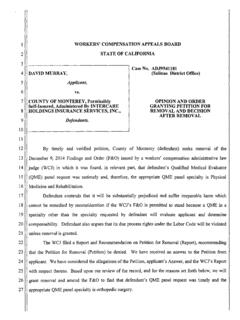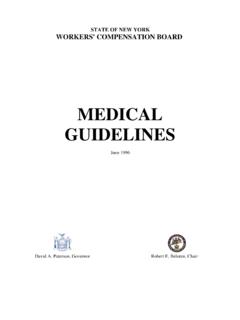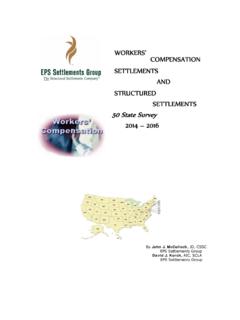Transcription of CALIFORNIA WORKERS’ COMPENSATION - Louielaw
1 CALIFORNIA WORKERS COMPENSATION 10 Important Cases Post SB 899 New QME Regulations Return to Work Issues May 17, 2010 PRESENTED BY: Peter E. Louie, Esq. Nishi C. Reddy, Esq. 303 N. GLENOAKS BLVD., SUITE 400 500 N. STATE COLLEGE BL, SUITE 1100 BURBANK, CA 91502-1116 ORANGE, CA 92868 (818) 461-9559 * (818) 461-9545 FAX (714) 919-4261 * (714) 919-4262 FAX 3323 WATT AVE., SUITE 264 225 BUSH ST., SUITE 1600 SACRAMENTO, CA 95821-3809 SAN FRANCISCO, CA 94104-4215 (916) 797-4580 * (916) 797-3056 FAX (415) 439-8365 * (415) 439-8371 FAX Website: CASAZZA v. Workers' COMPENSATION Appeals board , Petaluma School District, (2007), 72 Cal. Comp. Cas 1657 FACTS OF THE CASE This case involves Labor Code 4656(c)(1) and the new 2-year TTD rule. In this case an injury occurred on 4/22/2004 on a specific basis, and on a continuous trauma basis from 11/2003 through 4/22/2004.
2 Defendant made its first payment of temporary disability benefits on the case to the applicant on 1/26/2006. Applicant was a part-time teacher s aide and injury was initially denied, but later went to trial and the WCJ found the injury industrial; Defendant had to pick up benefits as a result. The F&A also found that the Applicant was TTD from the period of 4/23/2004 through 5/19/2006 to the present and continuing. Finally, the WCJ felt that the Applicant would be entitled to 208 weeks of additional benefits to run consecutively. In essence the WCJ ordered two periods of 104 weeks of TTD. Defendant filed a Petition for Reconsideration, contending that the WCJ exceeded the 2-year rule under Labor Code 4656(c)(1) and that TTD should have been awarded from the time that they were forced to pay back benefits on 4/23/2004.
3 ISSUES The main issues presented by this case were whether or not Labor Code 4656(c)(1) allows Defendant to take credit for previous periods of TTD that were paid retroactive as part of the 2-year rule, and whether an Applicant who has filed two separate claims can be entitled to 2 different 104-week periods of TTD under the new law. LAW As part of the SB 899 legislation, TTD benefits were limited to a 104-week period under most circumstances. Although there are exceptions to the rule, injuries after 4/19/2004 through 1/1/2008 effectively had only 104 weeks of benefits available. However, as the law was written, Labor Code 4656(c)(1) states specifically that Aggregate disability payments for a single injury occurring on or after 4/19/2004, causing temporary disability shall not extend for more than 104 compensable weeks within a period of two years from the date of commencement of temporary disability payments.
4 1 DECISION The WCAB on review of the case, upheld the Hawkins decision indicating that the date of commencement of temporary disability payments, as suggested in Labor Code 4656(c)(1), clearly indicates that TTD benefits are due from that point on, up to a maximum of 104 weeks. In the instant case Defendant paid benefits for the first time on 1/26/2006, therefore Applicant would be entitled to benefits starting from that point on for 104-week period. The argument that TTD benefits should have been credited beginning the period of time that the F&A found [4/21/2004] was rejected by the board based on the clear wording of the law. Secondly, as to the argument that Applicant would be entitled to two periods of 104 weeks running consecutively, given that Applicant filed two separate injuries, the Court felt that the evidence has to support successive periods of TTD in order for Applicant to get more than 104 weeks of benefits, even when filing two separate injuries.
5 The evidence must be looked at closely to see if there is evidence that that there are different periods of disability, that did not run concurrently, and if so, and under those circumstances, it is possible for an Applicant to get more than 104 weeks of benefits when filing two or more injuries. In the instant case however the injury was to the same body parts, and the evidence showed that both injuries caused TTD benefits that began on 4/23/2004 and forward. As a result, the WCAB suggested that the benefit would have run concurrently in the instant case. PRACTICE POINTERS First of all, it should be noted that the TTD laws were later readdressed for injuries after 1/1/2008. Under Labor Code 4656(c)(2), injuries after 1/1/2008 allow for aggregate disability payments for a single injury causing temporary disability for 104 compensable weeks within a period of five years from the date of injury.
6 As a result, the commencement of benefit issue is no longer an issue for injuries after 1/1/2008. We have from the date of injury five years to collect 104 weeks for each single injury, and after the Casazza decision, it appears that multiple injury filings case result in multiple period of 104 weeks, so long as the evidence suggests that the respective injuries caused different periods of temporary disability. As a result, for each injury that is filed by an Applicant, the claim should clearly indicate which TTD law would apply, and appropriate benefit limitations should be indicated as such. Labor Code 4656(c)(2) is much better written, and allows for an additional time period for the Applicant to obtain TTD benefits. The confusion over when benefits were commenced is no longer an issue, and Applicants who make a decision to hold off on invasive surgeries or 2 extensive treatment cannot hold off on that decision and ponder the issue, rather than rush to go forward with the procedures based on the limitation of TTD.
7 Please also note that there are still several cases that are litigated over the issue of the exceptions to the rule under Labor Code 4656(c)(3), which include injuries involving hepatitis, amputations and HIV. Please note that Applicant attorneys will usually find exceptions to the rule, which would allow an Applicant to obtain up to 240 compensable weeks of benefits for the period of five years from the date of injury. 3 JESUS CERVANTES v. El Aguila Food Products, Inc., (2009) 74 Cal. Comp. Cas 1336. FACTS OF THE CASE Applicant sustained back injuries in 1996, 1997 and 1998. In 2003 the Applicant entered into a Stipulated Findings and Award that allowed for future medical care to be open. Applicant began treatment later in 2008 and in that year there was a request for back surgery.
8 The first report was actually issued on 11/4/2008 suggesting that the Applicant may be a surgical candidate. Unfortunately that report did not clearly indicate that they were requesting authorization for surgery. Finally, on 2/25/2009 the treating doctor issued a request via fax for surgery authorization, and at that point Defendant obtained a UR report concluding that the surgery was not medically necessary. Applicant attorney filed for an Expedited Hearing on the issue of surgery arguing that the Applicant was entitled to surgery because the UR denial was not timely, and that Defendant did not object to the treating doctor s request for surgery, as would be required under the Spinal surgery Second Opinion Law, Labor Code 4062(b).
9 Defendant argued in response that the Applicant was not entitled to surgery because the initial 1/16/2009 report did not clearly suggest a need for surgery, and that the 2/25/2009 fax was the first clearly marked request for surgery, and that the UR denial was timely in response to that request, and finally that Defendant, by issuing a UR denial, placed the burden of proof of the Applicant to then proceed with the second opinion process. At trial, the WCJ issued a Findings and Award ordering Defendant to provide surgery, believing that the treating doctor s report was reasonable and appropriate, and that the UR report was not persuasive. Defendant filed a timely Petition for Reconsideration. ISSUES At issue is Labor Code 4062(b) Spinal Surgery Second Opinion Law that was enacted as part of SB 899.
10 4 LAW Labor Code 4062(b) states, The employer may object to a report of the treating physician recommending that spinal surgery be performed within 10 days of the receipt of the report. If the employee is represented by an attorney, the parties shall seek agreement with the other party on a CALIFORNIA licensed board -certified or board -eligible orthopedic surgeon or neurosurgeon to prepare a second opinion report resolving the disputed surgical recommendation. If no agreement is reached within 10 days, or if the employee is not represented by an attorney, an orthopedic surgeon or neurosurgeon shall be randomly selected by the administrative director to prepare a second opinion report resolving the disputed surgical recommendation. Examinations shall be scheduled on an expedited basis.






